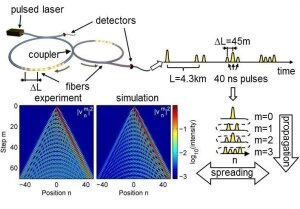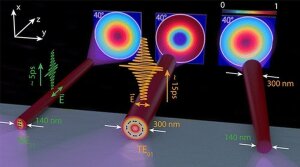
-
Quantum random walks in discrete fiber networks
Quantum Random Walks
Image: Ulf PeschelRandom walks are widely used in many areas of natural sciences to model the classical diffusion of incoherent particles. However, spreading of coherent light or the motion of quantum particles requires an implementation where wave interference is enabled resulting in a completely different and much richer dynamics. In our group we study booth theoretically and experimentally the random walk of coherent light pulses in an extended fiber network. We use a time-multiplexed setup of two coupled fiber loops, where a length difference ΔL enables a transverse spreading of pulses in time. If a light pulse travels in the short loop, it makes a shortcut and thus advances temporally.
Quantum technologies exploit non-classical properties such as quantum superposition and entanglement to devise techniques for imaging, sensing, secure communication, and computing. An important goal of our research is to come up with new ideas how to use synthetic quantum system as physical simulation devices to explore quantum many-body phenomena. This requires the development of methods for benchmarking these devices using tools from quantum information theory and machine learning. Specifically, we develop methods for efficiently characterizing quantum states from measurements, for example quantifying their entanglement, and for simulating quantum many-body physics on classical computers, thereby pushing the limits of numerical methods. Our goal is to explore fundamental limitations for quantum devices due to their inherent noisiness.
More information at: www.mbqd.deExternal link
-
Modeling semiconductor nanowire lasers
Modellierung von Halbleiter-Nanowire-Lasern
Image: Ulf PeschelSemiconductor nanowires can be grown easily and with high optical quality. As they form tiny resonators where photons are strongly coupled with the direct transition of the semiconductor material they are ideal candidates to form micro-optical circuit elements and nanolasers. As they are coherent nano-lightsources they form perfect links between electronic and photonic integrated circuits.
In our group we deal with the numerical modeling of lasing processes and of polaritonic effects in ZnO and CdS nanowires. To this end we have coupled electromagnetic modeling based on Finite Difference Time Domain (FDTD) calculations with quantum mechanical calculations (Semiconductor Maxwell-Bloch equations). Strong collaborations exist with various experimental groups in the framework of the DFG-Forschergruppe FOR1616.
- R. Buschlinger, M. Lorke, and U. Peschel, "Coupled-Mode Theory for Semiconductor Nanowires", Phys. Rev. Applied 7, 034028 (2017). DOI: 10.1103/PhysRevApplied.7.034028
- T. Michalsky, H. Franke, R. Buschlinger, U. Peschel, M. Grundmann, R. Schmidt-Grund, "Coexistence of strong and weak coupling in ZnO nanowire cavities", European Journal of Applied Physics 74, 30502 (2016) DOI: 10.1051/epjap/2016160093
- R. Buschlinger, M. Lorke, and U. Peschel, "Light-matter interaction and lasing in semiconductor nanowires: A combined finite-difference time-domain and semiconductor Bloch equation approach", Phys. Rev. B 91, 045203 (2015) DOI: 10.1103/PhysRevB.91.045203External linkExternal link
- R. Röder, D. Ploss, A. Kriesch, R. Buschlinger, S. Geburt, U. Peschel, C. Ronning, "Polarization features of optically pumped CdS nanowire lasers", Journal of Physics D: Applied Physics 47 394012 (2014). DOI:10.1088/0022-3727/47/39/394012
-
Nonlinear dynamics of polaritons
The group has a strong history with manifold contributions to the fascinating physics of nonlinear optics in artificial photonic structures such as, for instance, coupled waveguides, nonlinear microresonators and photonic crystals. This research is primarily devoted to systematic control and modification of light by its linear and nonlinear interaction with matter. In particular we study the influence of artificially modified dispersion and diffraction properties of light on fundamental phenomena of nonlinear dynamics. Among these are optical bistability, modulational instability, parametric interactions and formation of robust self-localized states also known as solitary waves. A general aim of this research is the development of compact on-chip all-optical devices for novel light sources, signal processing and high-resolution imaging.
Nonlinear optics in periodic photonic structures
Here we focus on intensive numerical and analytical studies of the light dynamics inside artificial photonic structures endowed with a non-resonant optical nonlinearity (cubic or quadratic). A complete photonic device can be implemented "on-chip" at micrometer scale inside an appropriately patterned photonic crystal slab. An example is an all-photonic crystal resonator made of a high-index material (like GaAs) with an instantaneous Kerr-nonlinearity (see Fig. 1a). This "on-chip" device shows an optical bistability and can be considered as an essential building block of any logical operation. Due to nonlinear self-collimation the light focuses into a narrow region forming a robust localized object with well-defined shape and power, also called dissipative soliton. This robust localized object can be switched on and off and even shifted at any position along the device at will (Fig. 1b).
The photonic crystal changes the diffraction properties of light reducing drastically the size of dissipative solitons, and as a consequence the operation power of the device. This can be exploited for the purpose of fast low-power all-optical switching with a potential switching frequency of several hundreds of GHz.
Nonlinear optics in the regime of strong light-matter coupling
Here we study the nonlinear dynamics of light trapped in a tiny volume of micro-resonators, close and even beyond the diffraction limit. The light strongly interacts with the host material, creating significant nonlinear and quantum electrodynamics effects. An example is a planar microresonator with embedded semiconductor quantum wells (see Fig. 2a). The striking change of optical properties occurs when the conditions for the strong light-matter coupling regime inside a resonator are fulfilled. Under such conditions, the elementary excitations of the system can no longer be described as barely photonic, but rather as hybrid radiation-matter states, i.e. light and matter entangle and form a new quasi-particle called exciton-polariton. In the linear limit they exhibit a dispersion relation with two branches, called lower- (LP) and upper-(UP) polariton branches, separated by a gap (Rabi splitting) (see Fig. 2b). The new physics of this system originates from the half-light half-matter nature of polaritons. They are characterized by a strong nonlinearity and fast relaxation dynamics.
An important feature of the strong light-matter interaction is that strength and sign of the polariton dispersion can be controlled by changing the transverse momentum by means of inclination of the pump beam (see Fig. 2b). It leads to new degrees of freedom for the control of light. For instance, this makes possible the realization of very effective parametrical four- wave mixing processes or the formation of robust localized states moving with a given velocity in the plane of the cavity (see Fig. 2c).
Dynamics of light
Image: Prof. Dr. Ulf Peschel -
Optical properties of hybrid nanostructures
Optische Eigenschaften hybrider Nanostrukturen
Image: Ulf PeschelThe junior research group investigates nanostructured devices for spectroscopy, microscopy, photovoltaics and catalysis. The fundamental optical response of plasmonic and dielectric systems is considered from a classical electromagnetic perspective, including properties of amorphous materials, rough interfaces, nonlinear and semi-classical interactions. The aim is to realistically describe complex nanoparticle distributions and ultrathin multilayers with reliable and rapid methods of computational nanophotonics while extending its scope towards multiphysics aspects.
Nonlinear and non-classical properties of amorphous Iridium heterostructures as well as mutlilayers are investigated within the CRC 1375 NOA "Nonlinear optics down to atomic scales" together with experimental groups at the Institute of Applied Physics. Hereby, we develop and implement analytical models and numerical methods for a realistic description of the experimental situation.
With respect to multiphysics processes, we are interested in soft plasmonics, where charge interactions in ionic systems are studied in analogy to plasmons in solid metals. This can be used to describe, e.g. electrolytes or biological systems, such as nerve cell signaling.
- C. David, "TiO2 Self-Assembled, Thin-Walled Nanotube Arrays for Photonic Applications", Materials 12(8), 1332 (2019)
- W. Jacak, "On Modeling of Plasmon-Induced Enhancement of the Efficiency of Solar Cells Modified by Metallic Nano-Particles", Nanomaterials 9(1), 3 (2019)
- C. David, "Two-fluid, hydrodynamic model for spherical electrolyte systems", Scientific Reports, 8, 7544 (2018).
- H. Öner, C. J. Querebillo, C. David, U. Gernert, C. Walter, M. Driess, S. Leimkühler, K. H. Ly, I. M. Weidinger, "High electromagnetic field enhancement of TiO2 nanotubes electrodes", Angewandte Chemie International Edition, 57, 7225–7229 (2018)
- C. David, J. Christensen, und N. A. Mortensen, "Spatial dispersion in 2D plasmonic crystals: Large blueshifts promoted by diffraction anomalies", Phys. Rev. B 94, 165410 (2016)



